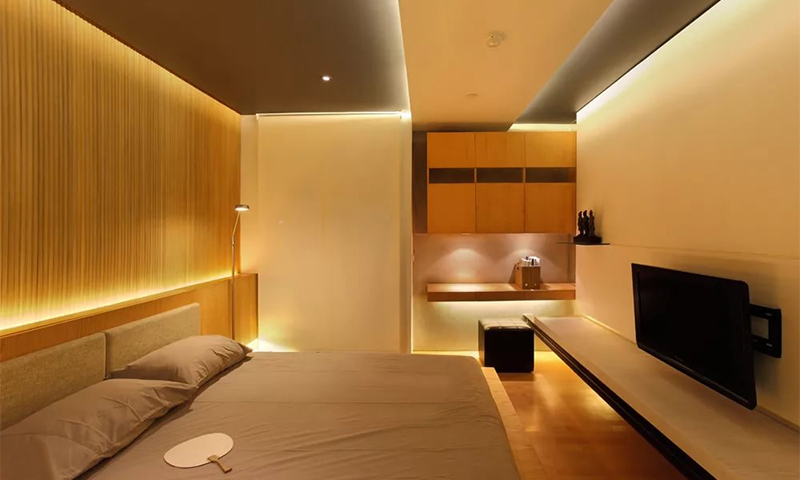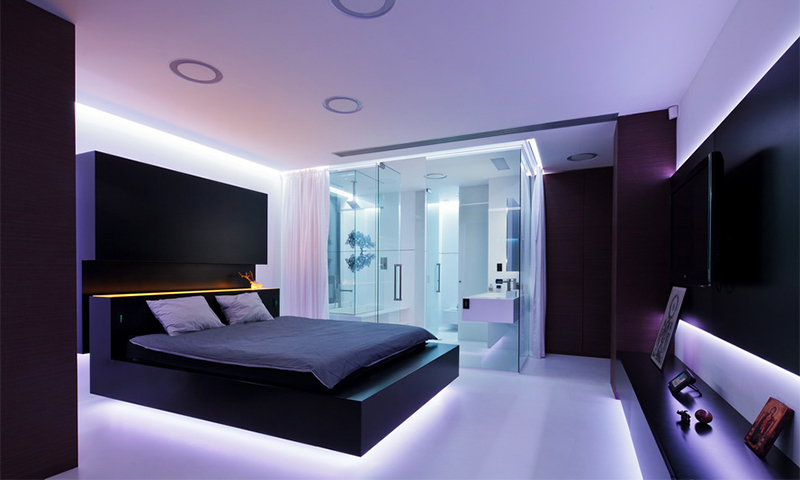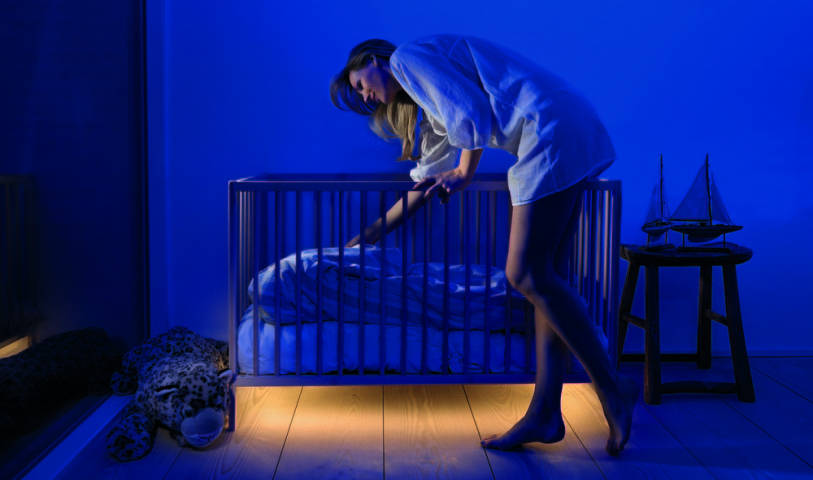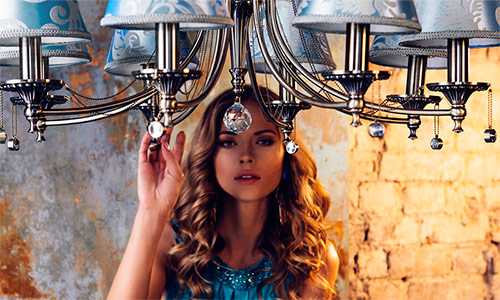LED strips - new and slightly unusual lighting. Initially, they were used to create outdoor advertising, as well as in the decoration of rooms (niche lighting, multi-level ceilings and openings). But now they are ready to completely replace the boring chandeliers and sconces in our homes. The benefit of this solution is obvious - the diodes consume very little electricity, and they shine more brightly than other “Ilyich light bulbs”. It remains only to choose the right type of LED-tape and calculate the desired power of the light flux.

Content:
The best manufacturers of LED strips - which company to choose
SD tapes today are at the peak of interior fashion, so they are produced by all and sundry: from popular brands to lesser-known manufacturers from China. This technique is simple and quite reliable, so there is always a chance to find at a modest price a good diode tape that will serve you for years.
But if you do not want to play this lottery, it is better to immediately select the device of a famous European or Russian manufacturer.
Guaranteed high quality LED strips you get if you purchase the products of the following companies:
- Sveteco;
- Joliet Technologies;
- LEDCraft;
- Cree;
- Arlight.
We will review the best samples of CDs from these companies in a separate article. In the meantime, let's see what this technique is, and what characteristics you need to pay attention to when choosing it.
The principle of operation and the device LED strip

The LED tape is one continuous flexible payment with a row of the diodes soldered to it. They are located at the same distance from each other for the most uniform dispersion of light.
The board is connected to a special power supply unit that supplies 12-24 V voltage to the LEDs, reducing the values obtained from the network 220. The tape itself can be placed in a transparent polymer tube or have a self-adhesive layer - to simplify installation.
All ribbons come with contact pads, allowing you to increase their length and assemble a chain of individual pieces. On them it is possible to cut the flexible "lamp" to get short strips. Sites are connected to each other by soldering or a more civilized method - using an LED connector.
Ultra-thin tape is convenient to install, because its width is 8-10 mm, and its height is only 3, which allows installing LEDs even in hard-to-reach places and with minimal “loss” of space. In addition, LED strips spend very little energy, but produce enough light to fully illuminate the room.
Types of LED strips
Monochrome SMD

SMD LED strips are the most common, and their cost is usually lower than that of multi-color diodes. SMD can give a red, blue, green, yellow glow.
Also today there were products of intermediate tones - for example, purple or orange. And those that come in white (CW), allow you to additionally choose any of three shades: warm, cold or neutral.
The color of the ribbon depends on the color of the crystals used in the LEDs. And by the way, there are no whites among them - in order to obtain a natural glow, manufacturers simply put a phosphor on a blue crystal. Over time, it burns out, and the “white” ribbon shows its true color.
Pros:
- A nice selection of shades;
- Compact size and ease of installation;
- Availability of tapes of various capacities;
- Economical energy consumption and long service life;
- Ability to use as an independent light source;
- Cost cheaper multi-color RGB tapes.
Minuses:
- There are many poor-quality Chinese fakes on the market;
- Good tapes from well-known manufacturers are expensive.
- Improper color can spoil the impression of the interior.
Multi-color RGB

RGB-tapes in the glow issue thousands of various shades. Here, each LED contains crystals of three primary colors: blue, red and green. It is enough to “mix” them in a certain proportion - and you will get any shade you wish.
For the combination and change of colors, there is a special controller that adjusts the saturation, intensity and brightness of the diodes. It is thanks to him that RGB tapes are able to work in the mode of cyclic change of color, flickering or “treadmill”.
Pros:
- Bright, diverse and rich colors;
- The ability to automatically change the color or the inclusion of "special effects";
- Still economical power consumption;
- Easy setup with remote control.
Minuses:
- The cost of RGB tapes is 2-3 times higher than monochrome;
- Not suitable for mainstream lighting.
Multi-color LEDs make it possible to decorate the house from the inside and outside, to highlight cars and even advertising signs, if you use tapes with a good degree of dust and moisture protection.
LED strip selection options

Lighting power (brightness)
By the four-digit index on the marking, you can determine the brightness and quality of the glow of the tape.
In accordance with this parameter, several types of diodes are distinguished:
1. 3528
Not too popular ribbons with low luminous intensity (up to 4.5-5 lm). Such SMD-devices are used only in the decor: as a ceiling light, shelves, closet or working surface of the kitchen table.
Their installation and as auxiliary lighting together with other lamps in living rooms is allowed. As an independent source of light, 3528th ribbons are not used because of too weak and muffled luminescence.
2. 5050
Tapes with such power (as well as their analogues 5055 and 5060) are much more common. According to the characteristics, they practically do not differ from each other, except that the 5055s and 5060s diodes are slightly longer, but they give the same luminous flux of 12-14 lm.
In general, such lamps are bright enough to perform the functions of not only auxiliary and decorative, but also the main lighting in the room. If you choose the last option, remember: for every 8 square meters. m rooms you will need 5 m 5050th tape.
3. 2835
It uses very bright diodes (24-28 lm), and the tape itself gives a narrowly focused and more powerful stream of light compared to its predecessors. Because of this, 2835 are more often used to organize full-fledged lighting of rooms at the rate of 5 m of tape per 12 square meters. m
Here in the decor, such models do not look - too bright light emphasizes minor defects of the interior and hurts the eyes. However, in spacious rooms with the use of color SMD variants these problems can be avoided.
4. 5630 (5730)
Under this marking are sold the brightest and most powerful diodes. Such tapes are often used as the main lighting in shops, offices - any premises of a large area.
Diodes give out up to 75 lumens of a narrow beam of light and at the same time they heat up significantly, so experts do not recommend mounting them on an aluminum profile or under a polymer stretch ceiling.
Protection level
Another important factor when choosing a LED strip is its level of protection from dust and moisture:
1. ip20 is the cheapest open tape designed for dry and clean rooms (bedrooms, nurseries, living rooms, large halls).
2. ip23, ip43, ip44 - here already the level of dust and moisture protection is more serious, which allows the use of LED-tape in wet rooms or unheated rooms like a loggia. It is also allowed its installation on the floor and baseboards.
3. ip54, ip65, ip68 - sealed tape, hidden in a silicone cocoon, can be installed in rooms with high humidity, as well as used in external lighting. With a good level of protection, the LED strip is capable of operating in the temperature range of -25 .. + 60 ° C.
Controller type
The controller is required to control the operation of multi-color RGB-tapes. Its main task is to change the colors, saturation and brightness of the selected hue upon a command from the console or in accordance with a given program. It is placed between the tape and the power supply.
There are the following types of controllers:
1. Without the remote control - the most simple and cheap, having one "sewn" program smooth change colors.
2. With IR remote control - these settings have more options, but the controller itself will have to be placed in the “visibility” zone of the console. The price of such a device depends on the number of built-in functions.
3. With radio control - on such a controller, you can send a signal even from another room. The beauty is that there are always a lot of options for adjusting the glow - you will have about 10 thousand colors and a huge selection of different modes at your disposal.
Occasionally there are controllers working via Wi-Fi on the market - they are controlled through a special application in the smartphone. But in terms of functionality, such devices are no better than radio models, so there is no particular reason to overpay for them.
The main thing is to choose the correct controller power from the standard range (72, 144, 180 or 288 W). If it is lower than your LED strip requires, the device may soon fail.
Power Supply
For correct and continuous operation of the diode lighting, it is necessary to select the appropriate power supply. It usually does not come bundled, so it will have to be purchased separately.
BP is chosen according to the length of the tape and the amount of energy consumption on each running meter, simply multiplying these values and rounding the result up.
The power of the LED-lamp, in turn, depends on the density of the chips and the intensity of the luminous flux produced by them. For example, the SMD tape 3528, which has 60 diodes per meter, consumes 4.8 watts, and 5050 at the same density — already 15 watts.
What LED strip to choose

1. For the decoration of shelves or racks SMD-tape 3528 of any shade will be enough. High power is not required here, so choose the simplest one - for 60 diodes / m.
2. In the nursery or bedroom to create auxiliary lighting is better to take the same SMD 3528 or 5050, but with a soft white glow - a warm or neutral shade.
3. For the organization of additional or replacement of the main lighting in living rooms, halls and large rooms, tapes with a capacity of 5050 or 2835 are suitable. Here are quite bright diodes that perfectly cope with the functions of traditional lamps.
4. For offices, shops and street windows choose SMD 5630-5730. They are very powerful and bright diodes that cope with the illumination of large areas.
5. If you are an avid car enthusiast and want to stand out from the gray mass, to illuminate the car, you can choose a tape of any color SMD 5050 or multi-color RGB - both with a protection level not lower than ip54.
6. For a bright shop or cafe sign, choose multi-color RGB-tapes in a silicone shell with protection from ip65 and higher. It is also advisable to purchase a radio-controlled controller to create unusual color effects.
How much is LED tape

1. The cost of SMD 3528 starts from 50 rubles per meter for a simple product and reaches 340 rubles if it is a product of a well-known brand with a high degree of dust and moisture protection.
2. An SMD tape with diodes of the 5050th type and a planting density of 30 pcs / m will cost the buyer 100 rubles per meter, a double-density “lamp” for 60 diodes - 150 rubles / m.
3. The most unpretentious 2835th tape will cost about 95-130 rubles / m. For a good model that allows outdoor use, you can give up to 1,100 rubles per meter.
4. SD tape with 5730 diodes is in the range of 110-470 rubles / m.
5. Multi-color RGB - the most expensive. Here, the price ranges from 490-3300 rubles per square meter.
It will be interesting to friends too







